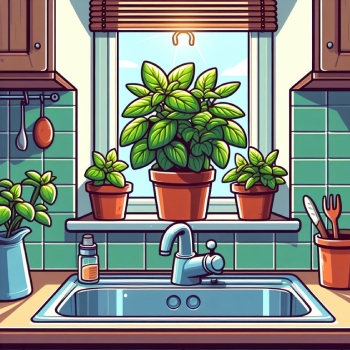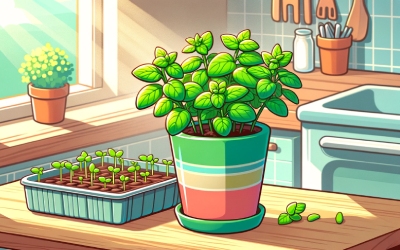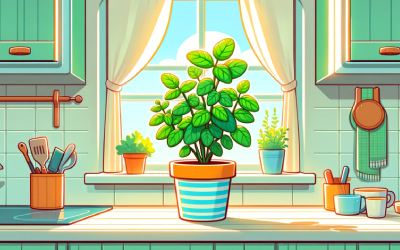Growing mint from seed
Let's start from scratch. Growing mint from seed might seem tricky and a lot of effort, especially with ready-to-go plants available from garden centres (or even Tesco!) - but it's easier than you think, and way more rewarding.
Seed selection and sowing
First things first, let's talk about picking the right seeds. Opt for high-quality mint seeds from a supplier you trust. Here's a quick table with some suitable mint varities for indoor UK growth:
| Indoor mint varieties |
Description |
| Peppermint (Mentha × piperita) |
Known for its strong menthol flavor, peppermint is a popular choice for both culinary and medicinal use. It thrives in indoor conditions with ample sunlight. |
| Spearmint (Mentha spicata) |
With a milder flavor compared to peppermint, spearmint is versatile in cooking and makes a refreshing addition to beverages. It adapts well to indoor environments with adequate sunlight. We've got a full fact box on spearmint a little later on in this article, by the way. |
| Chocolate Mint (Mentha × piperita 'Chocolate') |
This variety offers a delightful hint of chocolate in its aroma and flavor, making it a unique choice for culinary experimentation. It can be grown indoors with proper care and sunlight. |
| Apple Mint (Mentha suaveolens) |
Apple mint features a subtle apple-like fragrance and flavor, adding a refreshing twist to beverages and desserts. It thrives indoors when provided with sufficient light and moisture. |
| Lemon Mint (Mentha × piperita 'Citrata') |
With its citrusy aroma and flavor, lemon mint is perfect for adding a zesty touch to teas, cocktails, and salads. It can be grown indoors in containers with adequate sunlight. |
Sow
Grab a tray or pot – make sure it has good drainage. Fill it with a mix that your mint will love – something light and airy. Sprinkle the seeds on top, as if you're seasoning your favorite dish. Just a light covering is enough – mint seeds are sun worshippers and need light to kickstart their growth.
Germinate
Find a cosy spot with warm, indirect sunlight. Patience is key here – it usually takes about 10 to 15 days for mint to wake up and say hello. Keep the soil moist, but not too wet. A mist sprayer can be your best friend in this stage, giving your seeds the gentle touch they need.
Thin
Watch as your tiny mint plants reach for the sky. When they're a few inches tall, give them some room to breathe by thinning them out. Just like us, they need their space. Keep them happy with plenty of light and water when the topsoil starts getting a bit dry.

From seedling to plant
Once your mint seedlings have sprouted and reached a few inches in height, it's time to shift your focus to nurturing them into robust, mature plants. Here's what you need to know to guide them through this crucial growth phase.
Transplant
As your mint seedlings outgrow their initial tray or pot, it's time to transplant them into individual containers or into the garden if the weather permits. Choose pots with ample drainage holes to prevent waterlogging, and use a well-draining potting mix to ensure optimal root health. Gently lift the seedlings from their nursery tray, being careful not to disturb their delicate roots, and transplant them into their new homes at the same depth they were previously growing.
Space
When transplanting mint seedlings, ensure they have adequate space to spread out and thrive. Mint plants have a tendency to spread vigorously via underground runners, so providing ample space between each plant will help prevent overcrowding and competition for resources. Aim for a spacing of at least 12 to 18 inches between each mint plant to allow for ample growth and airflow.
Caring for and maintaining your indoor mint
So you've got a mint plant. Here's how to make sure it survives and thrives.
How often to water mint indoors
Mint’s like that friend who’s always thirsty — constantly craving a drink. But indoors, it’s a bit pickier than when it's out in the wild. You want to keep the soil moist, but not soaking wet. Stick your finger in about an inch deep — if it feels dry, it’s time to water. Easy, right?
Aim for watering every two to three days, but adjust based on how dry your indoor climate is. And here’s a bonus: mint loves humidity, so a spritz of water on its leaves now and then will make it feel right at home.
Ensure good drainage by using a pot with drainage holes and a well-draining potting mix. Consider using a moisture meter for accuracy or feel the soil with your finger to avoid over-watering.
Light
Mint requires about 4-6 hours of sunlight daily. If you can, place it near a sunny window, preferably south-facing.
If natural light is limited, supplement with grow lights, ensuring they're positioned close enough to mimic the sun's intensity but not so close as to burn the leaves. Rotate the plant regularly to ensure even light distribution.
Pruning and harvesting
Regular pruning is essential for a healthy, bushy mint plant. Snip off the top third of the stems when the plant reaches about 6 inches in height, which encourages lateral growth and prevents legginess.
Prune regularly to promote bushier growth and to prevent flowering, which can reduce the plant's vigor and alter the flavor of the leaves. Harvest leaves as needed, but avoid taking more than one-third of the plant at a time to keep it robust.
And guess what? If you're mint plant gets a little leggy or worn out, you can start again by cutting down to the bottom of the stem and covering with fresh soil. After a little while fresh shoots will grow.

Fertilisation and soil
Use a light application of balanced, organic fertiliser every 4-6 weeks during the growing season. Over-fertilizing can lead to lush growth with less flavor. Mint thrives in slightly acidic to neutral soil (pH 6.0 to 7.0). Use a quality potting mix and consider adding perlite or vermiculite to enhance drainage.
Bonus tips:
- Air circulation: Good air circulation helps prevent fungal diseases. Avoid overcrowding and provide enough space between your mint and other plants.
- Humidity: Mint plants prefer a humid environment. If your indoor air is dry, especially in winter, use a humidifier or place the pot on a tray of water and pebbles to increase humidity.
- Temperature: Mint plants grow best in temperatures between 18-22°C during the day and slightly cooler at night. Avoid placing your plant near heat sources or cold drafts.
Companion planting for mint plants
Let's talk about companion planting. Imagine your indoor garden as a bustling community where every plant plays a unique role. Mint, being the social butterfly it is, loves having some good pals around. Think basil, parsley, and chives – they're like the supportive friends who always have your back!
Companion planting isn't just about making your garden look pretty; it's like hosting a party where everyone brings something special to the table. Basil, for example, not only complements mint's flavor but also helps keep pests away with its aromatic charm. Parsley adds a fresh burst of green and attracts beneficial insects, while chives bring their zesty flair to the mix.
Best containers and pots for mint plants
There's a lot to think about when finding the right pot or container for your mint plant. Here's a quick runthrough:
1. Seedlings / young plants: Start with smaller pots, around 2-5 inches in diameter, to allow for initial growth without overwhelming the plant with a large container.
2. Mature plants: For mature mint plants, a pot that's around 5-10 inches in diameter should be sufficient. This size still provides enough space for growth while keeping the plant manageable in size.
3. Container depth: A depth of 5-8 inches should be adequate to accommodate the shallow root system of mint plants.
4. Growing environment: In indoor or limited space environments, smaller pots can be more practical. Regular pruning and harvesting can help manage the size of the plant within the confines of the pot.
5. Material: You've got lots of options. Terracotta pots offer a classic look and excellent breathability for your mint's roots. Plus, they absorb excess moisture, helping to prevent overwatering. If you prefer something lighter and more modern, plastic pots are a great choice. They're durable, easy to clean, and come in a variety of sizes and styles to suit your space. Or, if you're up for something quirky, you could check out some novelty plant pots to bring some colour and goofiness into your kitchen herb garden.
6. Consider the mint variety:
-
Peppermint vs. Spearmint: Peppermint (Mentha × piperita) tends to be more vigorous and spreads more aggressively compared to spearmint (Mentha spicata). If you're growing peppermint, you might opt for a slightly larger pot size to accommodate its faster growth rate and expansive root system. Spearmint, on the other hand, is generally less invasive and may thrive in a slightly smaller pot.
-
Other mint varieties: Aside from peppermint and spearmint, there are numerous other mint varieties available, each with its own growth characteristics. Some varieties, like chocolate mint or pineapple mint, may have unique flavors but exhibit growth habits similar to spearmint. Others, such as apple mint or orange mint, may have variegated foliage or distinct aromas but grow at a moderate pace like peppermint or spearmint.
-
Dwarf varieties: Some mint varieties are specifically bred to be more compact and restrained in their growth. Dwarf mint varieties, such as dwarf peppermint or dwarf spearmint, naturally stay smaller and are well-suited for smaller pots or container gardens. These varieties offer the advantage of mint flavor and aroma in a more confined space, making them ideal for indoor or patio gardening.
Pest management for indoor mint
Your indoor mint deserves the same level of care and attention as if it was in an outdoor garden. Just because it's indoors, doesn't mean it's safe from pests or disease - so it's essential to keep on the ball to avoid disaster.
Guarding against intruders: Regular inspection is your fortress against potential threats to your mint's vitality. Keep a close watch for culprits like spider mites, aphids, and whiteflies that might attempt to settle in.
Early detection: Make it a habit to inspect the leaves and stems regularly, searching for early signs of trouble such as webbing, discolored or distorted leaves, and the presence of tiny insects.
Natural safeguards: Use gentle organic solutions that won't compromise the well-being of your indoor mint. A delicate spray of soapy water or neem oil serves as a natural deterrent, maintaining the delicate balance of your indoor ecosystem while effectively managing pests.
Breathing space: Just like humans, mint plants relish a breath of fresh air. Ensure optimal air circulation around your indoor mint by avoiding overcrowding and providing ample space for the foliage to breathe. This not only reduces the risk of pests finding snug hiding spots but also fosters a healthier environment for your mint to thrive indoors.
Strategic watering: While mint enjoys moisture, excess water on the foliage creates a welcoming environment for unwanted visitors. Water the soil at the base of the plant, keeping the foliage as dry as possible. This practice not only deters pests but also minimizes the risk of fungal issues, ensuring your indoor mint enjoys a robust and disease-resistant life.

Propagating mint from cuttings
Got some mint and want more? Course you do! Here's your next steps.
Choosing cuttings:
Select a robust, healthy stem that's approximately 3-5 inches long. Make a clean cut just below a leaf node to encourage root growth.
Rooting process:
Prepare your mint cutting by removing the lower leaves. Place it in a glass of water, making sure the cut end is submerged. Change the water every few days to keep it fresh.
Transplanting:
Once you see roots develop, it's time to transplant your mint cutting into soil. Choose a well-draining potting mix, and keep the soil consistently moist. Ensure your new mint plant receives plenty of sunlight.
And that's literally it! Easy-peasy.
Other methods
Let's explore a couple more ways to propagate your mint: division and layering! These methods offer unique opportunities to expand your mint family and keep your indoor garden thriving.
Division is like mint matchmaking – you're separating a mature plant into smaller sections, each with its own roots. Start by gently removing the mint from its pot and carefully dividing the roots into smaller clumps. Then, plant these clumps into their own containers filled with well-draining soil. It's like giving each mint its own cozy apartment to call home!
Layering is a bit more like mint magic. With this method, you encourage new roots to form while the stem is still attached to the parent plant. Simply bend a low-hanging stem down to the soil, secure it in place, and wait for the magic to happen. Once roots have formed, you can snip the stem and transplant your new mint plant into its own container.
Using mint in the kitchen
Mint's culinary versatility is a true delight for home cooks. Here are some imaginative ways to incorporate mint into your kitchen creations:
Beverages:
Add a burst of freshness to your beverages by tossing in some fresh mint leaves. Whether it's herbal teas, mojitos, or simply infusing water, mint is your go-to flavor enhancer.
Urban gardening fact box: Spearmint 🪴
Spearmint thrives in partial shade and well-drained, moist soil, making it ideal for indoor cultivation. Its low maintenance needs and ability to grow rapidly make it a favorite among gardeners. In the kitchen, spearmint leaves lend a fresh, sweet flavor to a variety of dishes, including salads, sauces, and desserts. It pairs excellently with lamb, poultry, and seafood, enhancing their taste. Known for its cooling properties, spearmint is often brewed into refreshing teas or used as a garnish in cocktails.
Culinary uses:
Elevate your culinary creations with the addition of mint. Toss it into salads (spearmint is great for this), blend it into sauces, or sprinkle it on desserts for a zesty and refreshing twist.
Or get adventurous in the kitchen by experimenting with mint-infused dishes. Try your hand at making mint chutney, grilling up minty lamb chops, or baking delectable chocolate mint cookies.
Preservation:
Don't let your precious mint go to waste. Freeze mint leaves in ice cube trays with water or olive oil for convenient flavor bursts in future dishes. Alternatively, dry mint leaves for long-term storage and use in teas or recipes.

Case study: Growing spearmint indoors in the UK
Urban Gardening Hub's indoor mint plant journey
March 10
Today marks the beginning of our indoor mint growing adventure. With a packet of peppermint and spearmint seeds in hand, we're eager to see what the future holds for these aromatic herbs in our kitchen.
March 15
We spent the afternoon preparing the containers for planting. Ensuring proper drainage and selecting the right size pots were crucial steps in setting up the ideal environment for our mint babies.
March 20
The seeds have been carefully sown, and now it's a waiting game. We placed them in a warm, sunny spot and am keeping the soil moist as we eagerly await signs of sprouting.
April 5
Exciting news! The first tiny mint sprouts have emerged, filling us with joy and anticipation. We're already dreaming of the fresh mint tea and culinary delights that await.
April 10
As the mint seedlings continue to grow, we're amazed by their resilience and vigor. With proper care and attention to watering and light, they seem to thrive more each day.
April 13
Today, we repotted the mint seedlings into larger containers to accommodate their growing roots. It's incredible to witness their progress and know that soon, we'll be harvesting our own homegrown mint.
Watch this space for more updates!
And that's that! Looking for more guides about mint? Check out our related articles below.






